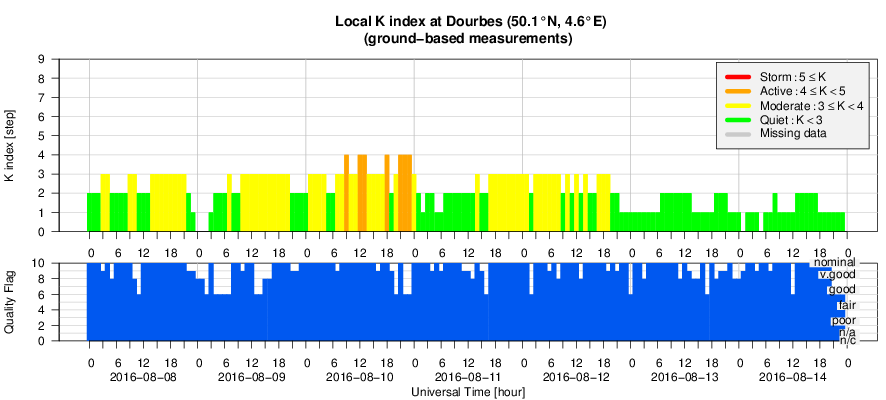- Table of Content
- 1.Falling Stars
- 2.PROBA2 Observa...
- 3.Review of sola...
- 4.The Internatio...
- 5.Review of geom...
- 6.Geomagnetic Ob...
- 7.Review of iono...
- 8.Future Events
2. PROBA2 Observations (8 Aug 2016 - 14 Aug 2016)
3. Review of solar activity
4. The International Sunspot Number
5. Review of geomagnetic activity
6. Geomagnetic Observations at Dourbes (8 Aug 2016 - 14 Aug 2016)
7. Review of ionospheric activity (8 Aug 2016 - 14 Aug 2016)
8. Future Events
Falling Stars
The public was invited to search in the night sky for falling stars of the Perseids, a meteorswarm between the prestigious couples of the observatory in Uccle. It was a great evening on August 10.
Enjoying falling stars, the view on the moon and planets, leaning about meteors and stars and their planets, detecting falling stars with radio waves and throwing a glimpse on the Schmidts telescope in a star dome.
Because images say more than 1000 words:
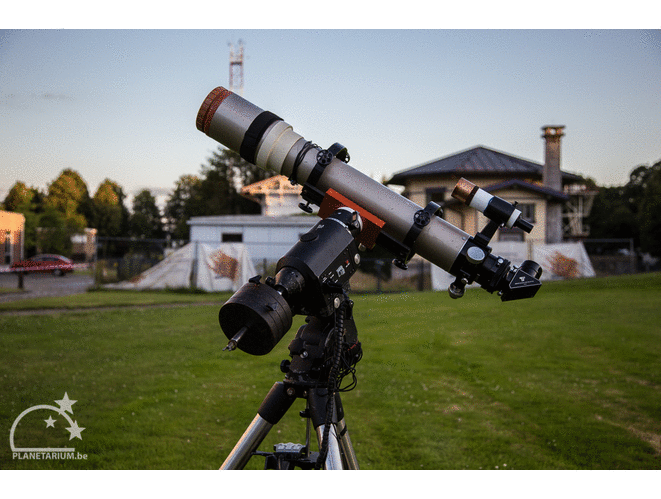
Credits: Hans Koeckelberghs
PROBA2 Observations (8 Aug 2016 - 14 Aug 2016)
Solar Activity
Solar flare activity fluctuated between very low and low during the week.
In order to view the activity of this week in more detail, we suggest to go to the following website from which all the daily (normal and difference) movies can be accessed: http://proba2.oma.be/ssa
This page also lists the recorded flaring events.
A weekly overview movie can be found here (SWAP week 333).
proba2.oma.be/swap/data/mpg/movies/weekly_movies/weekly_movie_2016_08_08.mp4
Details about some of this week's events, can be found further below.
If any of the linked movies are unavailable they can be found in the P2SC movie repository here
http://proba2.oma.be/swap/data/mpg/movies/
Monday Aug 08
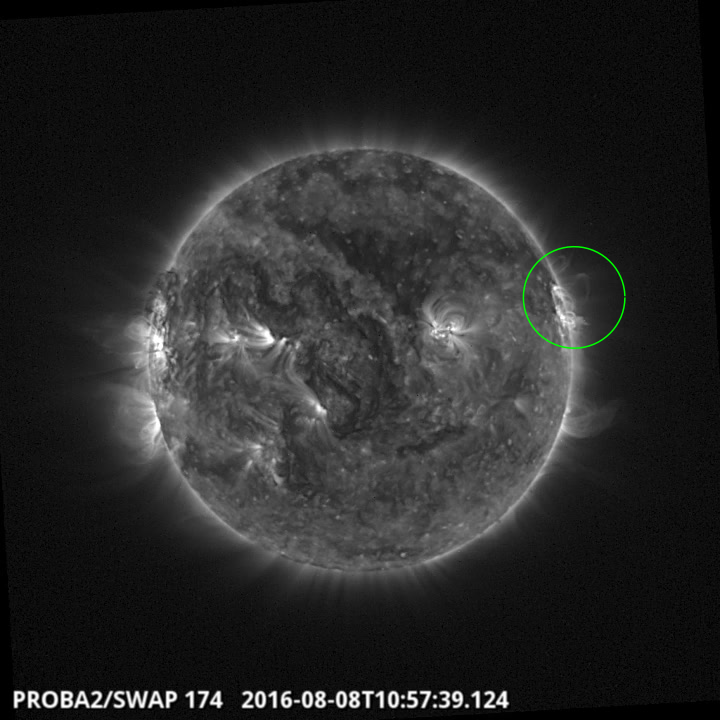
An eruption was observed by SWAP on the West limb of the Sun on 2016Aug08 at 10:57 UT
Find a movie of the event here (SWAP movie)
proba2.oma.be/swap/data/mpg/movies/20160808_swap_movie.mp4
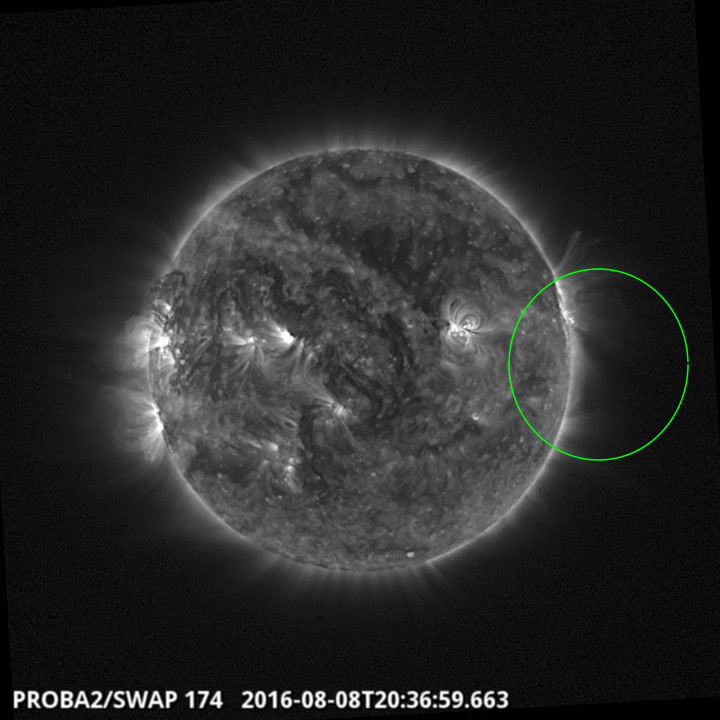
An eruption was observed by SWAP on the West limb of the Sun on 2016Aug08 at 20:36 UT
Find a movie of the event here (SWAP movie)
proba2.oma.be/swap/data/mpg/movies/20160808_swap_movie.mp4
Wednesday Aug 10
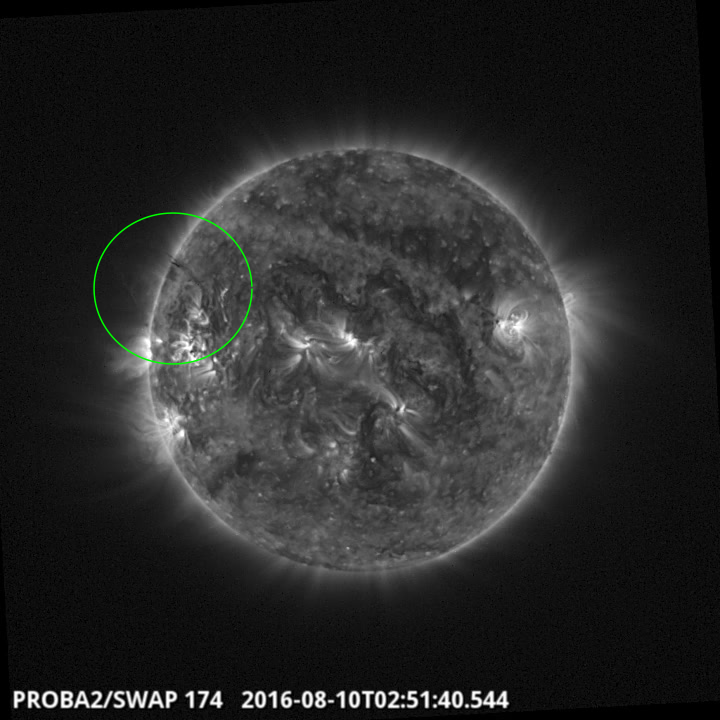
A small filament eruption was observed by SWAP on the North East limb of the Sun on
2016 Aug 10 at 02:51 UT
Find a movie of the event here (SWAP movie)
proba2.oma.be/swap/data/mpg/movies/20160810_swap_movie.mp4
Review of solar activity
During last week solar activity was low with only 10 C-class flares observed by GOES. The strongest flare was the C8.9 flare (peaked at 00:34 UT) on August 09. The flare originated from the NOAA AR 2574 situated close to the East solar limb, and was associated with narrow and slow CME.
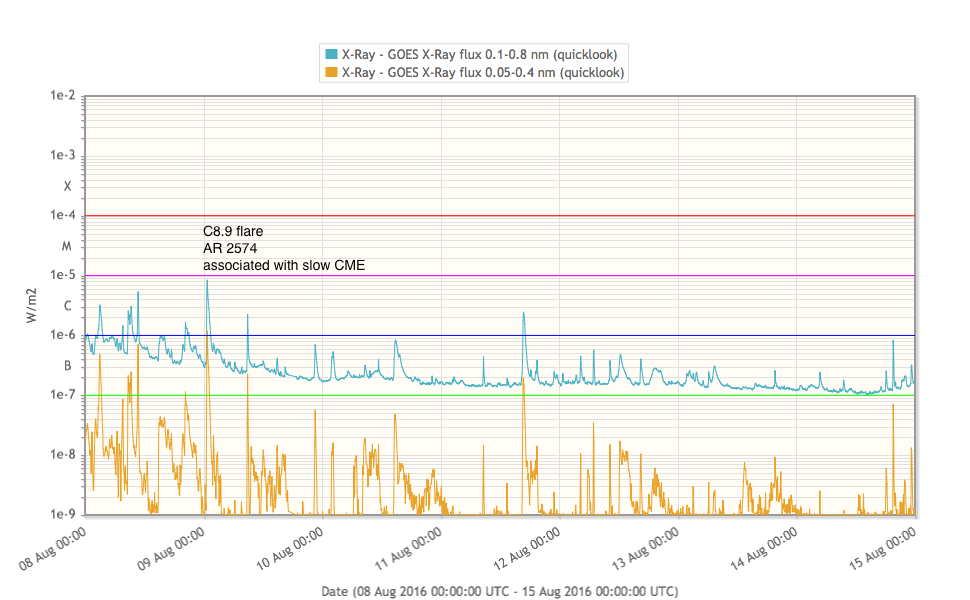
The only wide CME reported this week was first seen in the SOHO/LASCO C2 field of view at about 17:48 UT on August 13. The CME had angular width of about 100 degrees and speed of 400 km/s (as reported by CACTUS software). The CME erupted from the north-east solar limb and there was no clear on disk signature. Therefore, we concluded that the CME was not Earth directed.
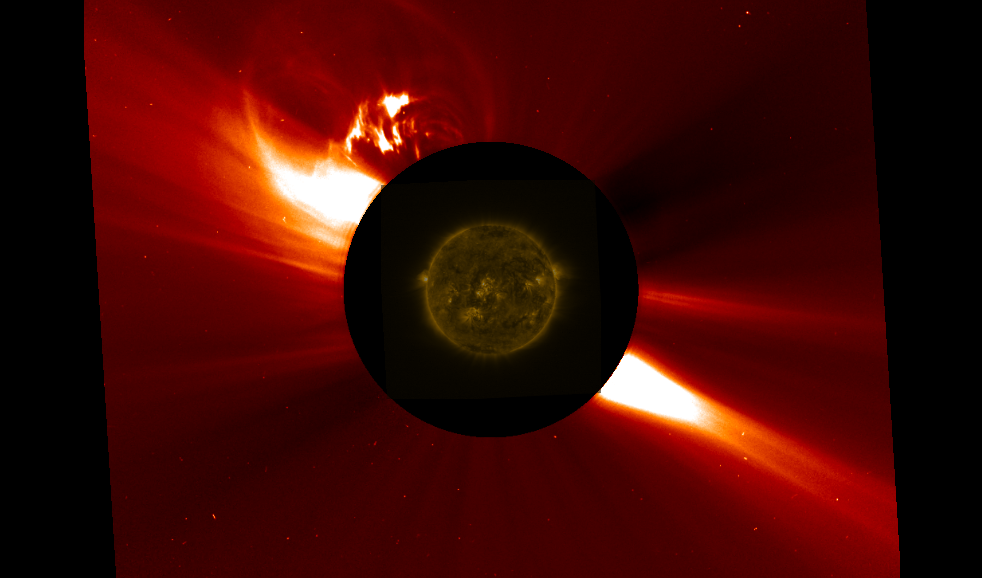
a movie: https://youtu.be/daLhj16rAfM
Only one coronal hole was reported this week. The low latitude coronal hole (between S15 and S35) reached the central meridian in the afternoon of August 11. Check it out in the SDO AIA picture below.
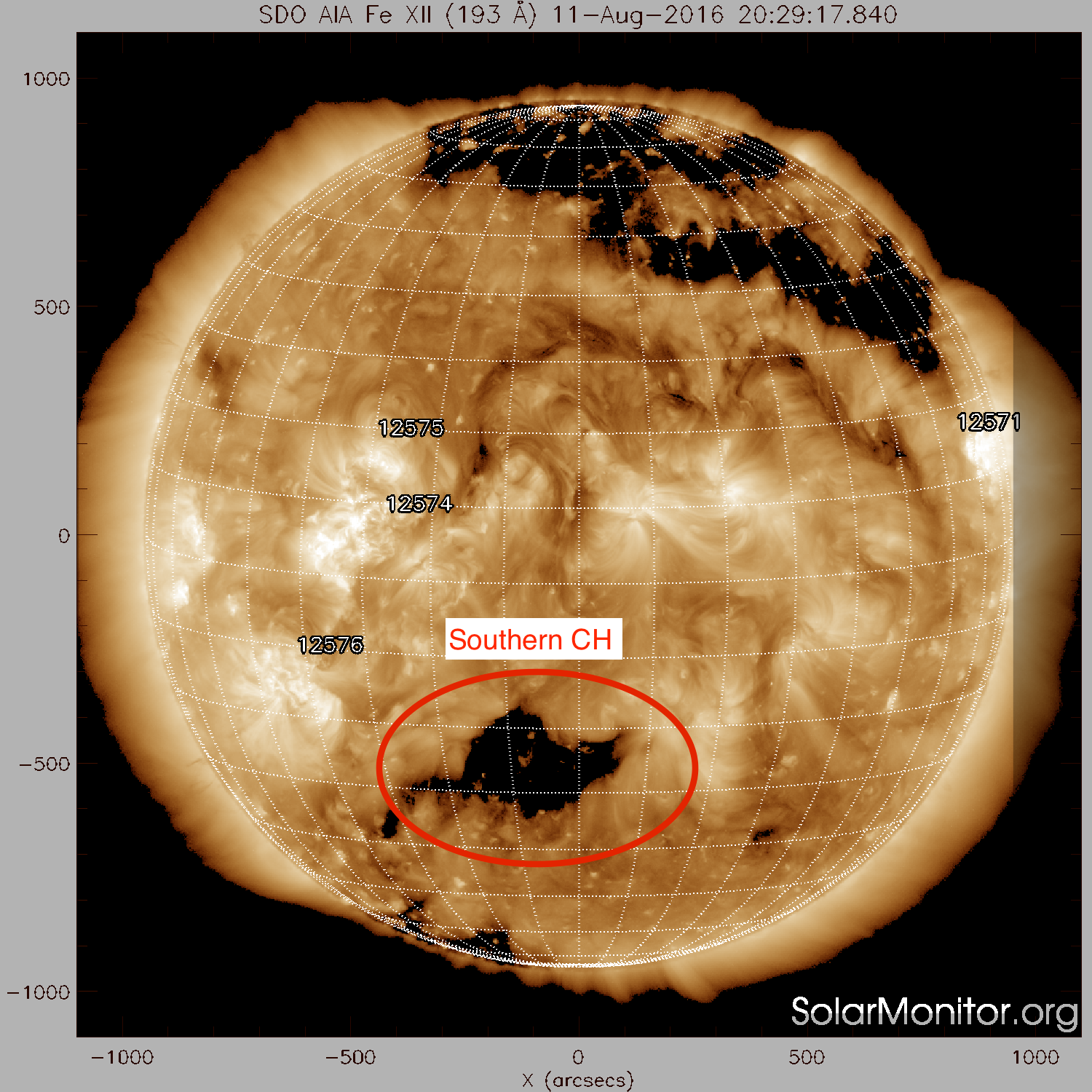
The International Sunspot Number
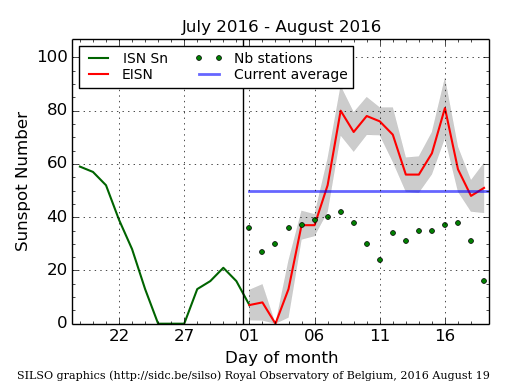
The daily Estimated International Sunspot Number (EISN, red curve with shaded error) derived by a simplified method from real-time data from the worldwide SILSO network. It extends the official Sunspot Number from the full processing of the preceding month (green line). The plot shows the last 30 days (about one solar rotation). The horizontal blue line shows the current monthly average, while the green dots give the number of stations included in the calculation of the EISN for each day.
Review of geomagnetic activity
The geomagnetic conditions were mostly quiet with only isolated intervals of unsettled to active geomagnetic conditions.
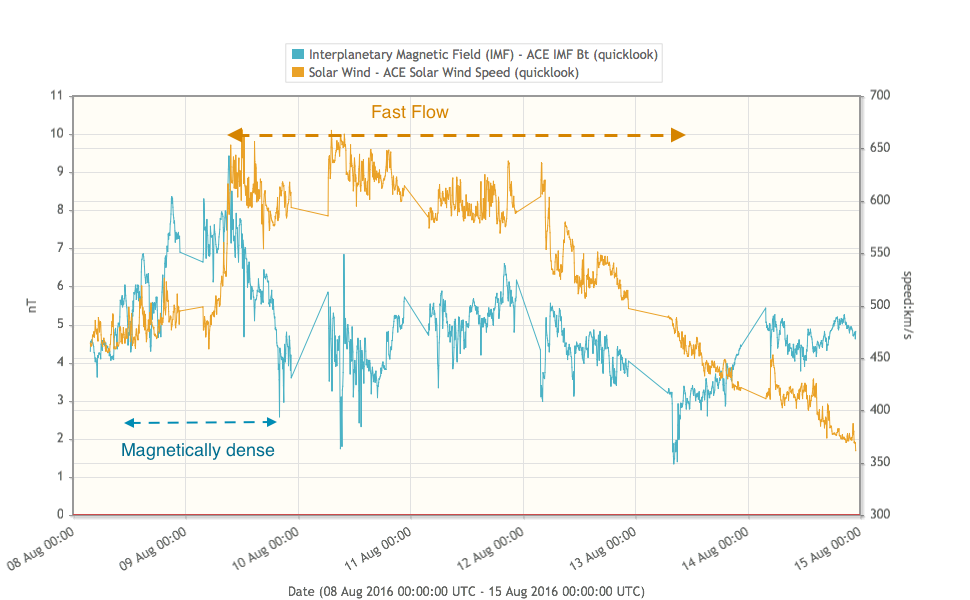
At about 09:00 UT of August 09, the solar wind speed started to increase, shown by the orange/brown line in the ACE graph above. This increases follows a magnetically dense region shown by the blue line representing the Bz component of the interplanetary magnetic field (IMF). There are several data gaps visible in the graph, you can recognise them as the straight lines spanning a few hours.
The solar wind speed and IMF behaviour indicate the arrival of a fast flow, associated with the large northern polar coronal hole with an extent to low latitudes. This CH reached central meridian on August 06 - see image below from HINODE/XRT.
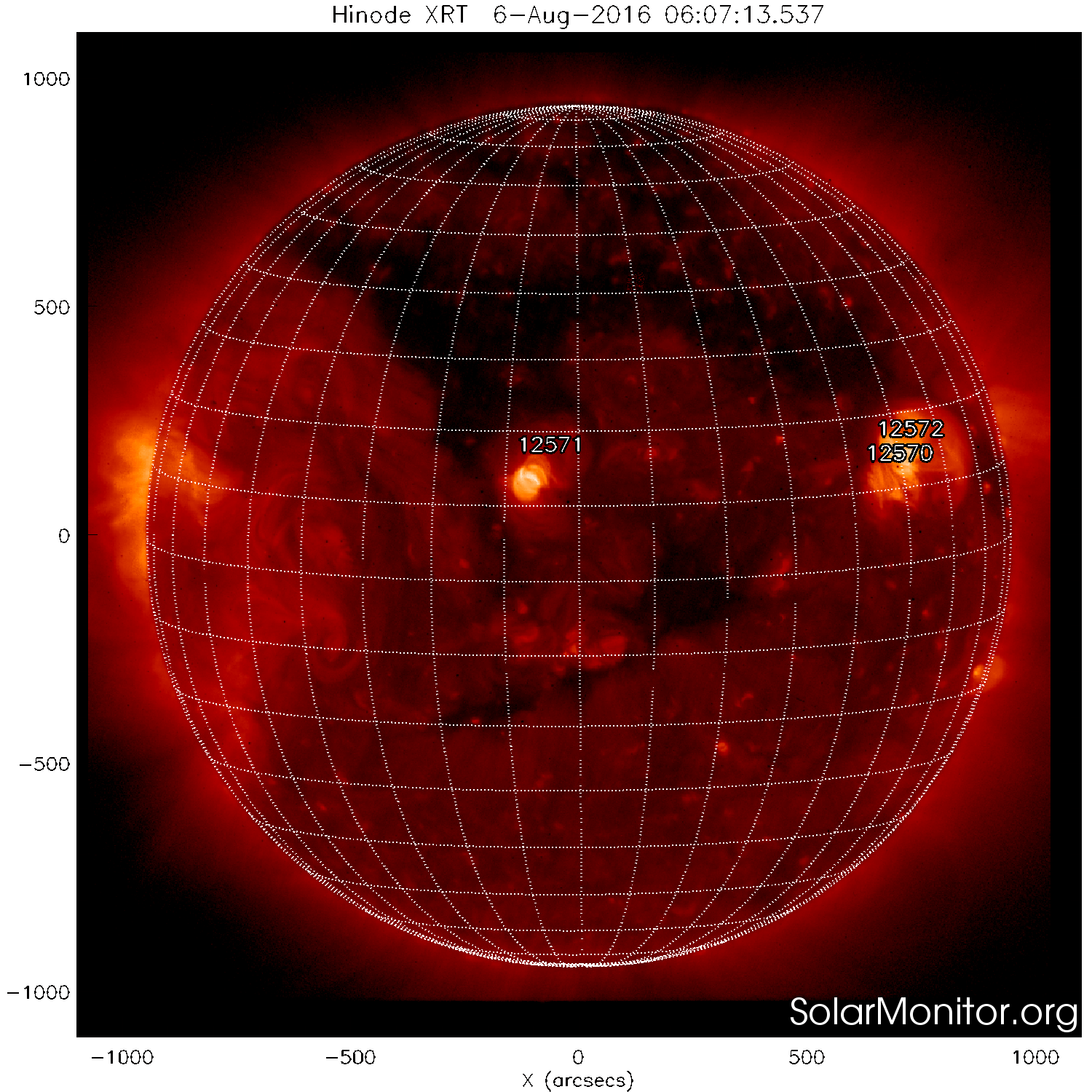
During most of the time this week, the Earth was inside this fast solar wind with the average speed of about 650 km/s. The arrival of the fast flow induced only few intervals of active geomagnetic conditions on August 10 and August 11 (local station at Dourbes reported intervals with K=4, and NOAA reported intervals of Kp=4).
Review of ionospheric activity (8 Aug 2016 - 14 Aug 2016)
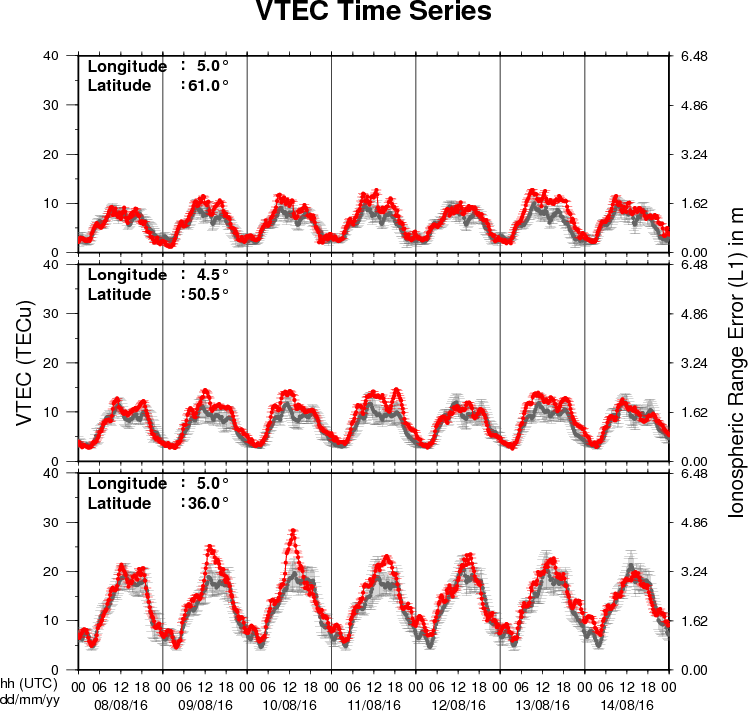
The figure shows the time evolution of the Vertical Total Electron Content (VTEC) (in red) during the last week at three locations:
a) in the northern part of Europe(N61°, 5°E)
b) above Brussels(N50.5°, 4.5°E)
c) in the southern part of Europe(N36°, 5°E)
This figure also shows (in grey) the normal ionospheric behaviour expected based on the median VTEC from the 15 previous days.
The VTEC is expressed in TECu (with TECu=10^16 electrons per square meter) and is directly related to the signal propagation delay due to the ionosphere (in figure: delay on GPS L1 frequency).
The Sun's radiation ionizes the Earth's upper atmosphere, the ionosphere, located from about 60km to 1000km above the Earth's surface.The ionization process in the ionosphere produces ions and free electrons. These electrons perturb the propagation of the GNSS (Global Navigation Satellite System) signals by inducing a so-called ionospheric delay.
See http://stce.be/newsletter/GNSS_final.pdf for some more explanations ; for detailed information, see http://gnss.be/ionosphere_tutorial.php
Future Events
For more details, see http://www.spaceweather.eu/en/event/future
Horizon 2020 Space Work Programme 2018-2020 Stakeholder Consultation Workshop, in Brussels, Belgium
Start : 2016-09-26 - End : 2016-09-28
In the context of preparing the Horizon 2020 Space work
programme 2018-2020, the European Commission organises a dedicated
stakeholder consultation workshop. The main objective of this event
is to further involve all relevant European stakeholders in the
definition of the next Horizon 2020 Space work programme,
highlighting the main priorities and trends.
The participation to the workshop is free and open to all
relevant stakeholders, limited only by the capacity of the
conference rooms. Delegations, European associations and other
stakeholder groups are encouraged to forward this invitation to
their respective constituents and members.
Website:
https://h2020-space-wp-2018-20.teamwork.fr/en/programme
4th Asia Oceania Space Weather Alliance (AOSWA) Workshop, in Jeju, Republic of Korea
Start : 2016-10-24 - End : 2016-10-27
Website:
http://aoswa4.spaceweather.org/index.php
Global Modelling of the Space Weather Chain in Helsinki, Finland
Start : 2016-10-24 - End : 2016-10-28
This event brings together solar, heliospheric, magnetospheric,
and ionospheric communities to discuss the current state and future
challenges in global modelling of the entire space weather chain.
Major developments in forecasting space weather, and understanding
the effects of solar eruptions requires increased communication and
collaboration of these often rather distinct communities. We
welcome submissions from these modelling communities and also
synergetic studies utilising both observations and numerical
models.
Website:
https://pnst.ias.u-psud.fr/sites/pnst/files/global_modelling_space_weather_oct2016.pdf
European Space Weather Week in Ostend, Belgium
Start : 2016-11-14 - End : 2016-11-18
The ESWW is the main annual event in the European Space Weather
calendar. It is the European forum for Space Weather as proven by
the high attendance to the past editions. The agenda will be
composed of plenary/parallel sessions, working meetings and
dedicated events for service end-users. The ESWW will again adopt
the central aim of bringing together the diverse groups in Europe
working on different aspects of Space Weather.
Website:
http://www.stce.be/esww13/
4th SOLARNET Meeting: The Physics of the Sun from the Interior to the Outer Atmosphere, in Lanzarote (Spain)
Start : 2017-01-16 - End : 2017-01-20
The IV SOLARNET MEETING 'The physics of the Sun from the
interior to the outer atmosphere' will take place in Lanzarote
(Spain) from 16th to 20th of January 2017, organized by the
Instituto de AstrofÃsica de Canarias (IAC).
SOLARNET (High-resolution Solar Physics Network) is an EU-FP7
project coordinated by IAC with the aim of bringing together and
integrating the major European research infrastructures in the
field of high-resolution solar physics. SOLARNET involves all
pertinent European research institutions, infrastructures, and data
repositories. Networking activities, access to first-class
infrastructures and joint research and development activities are
being covered under SOLARNET to improve, in quantity and quality,
the service provided by this European community.
The purpose of this conference is to provide a coherent picture
of the Sun as a single physical system playing all the underlying
physical processes measured and observed in the solar atmosphere to
date.
Website:
http://www.iac.es/congreso/solarnet-4meeting/
Solar Orbiter Workshop 7: Exploring the solar environs in Granada, Spain
Start : 2017-04-03 - End : 2017-04-06
This event will be hosted by the Instituto de Astrofisica de
Andalucia - CSIC. Please mind that on April 7th the 20th SWT
meeting will take place at the same venue.
Website: Unkown
